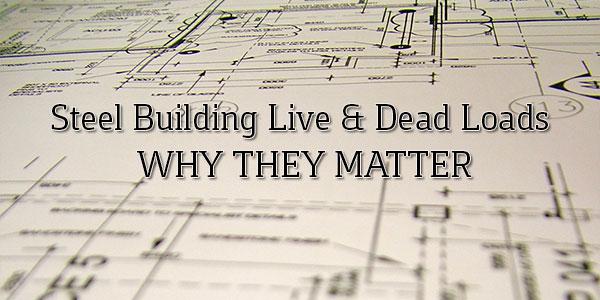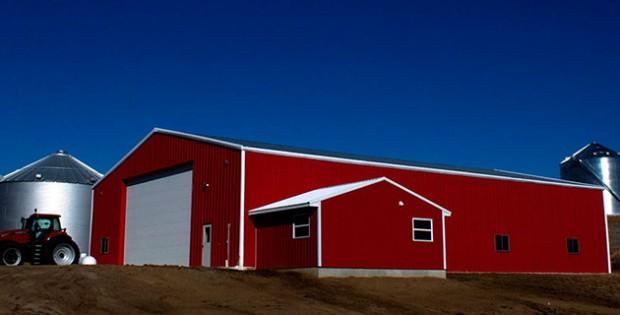Steel Building Live Loads & Dead Loads – Why They Matter

Ask a structural engineer what they do for a living. They might tell you they’re a creative designer. It’s possible they might call themselves creators. I’d like to go a different route. I think we’re a bunch of problem solvers.
Once you buy a steel building, your plan makes its way to my desk. In this case, your design isn’t what I would consider a problem. It’s important to understand you’re not buying a building system that comes off a shelf. Every building I design is unique because every person has unique needs. But it’s also unique because everyone else has different circumstances. One of those circumstances that I have to be intimately aware of is a building’s location. That’s where loads and codes come into play.
Loads are one of the most important factors in any building design because they define the nature and the significance of external forces and potential threats that a building must endure to provide a realistic performance throughout it’s lifetime. Its loads are influenced by a buildings intended use, size and shape and location. That’s where things can get tricky. Enter the problem solver.
When your “idea on paper” actually hits my desk, it’s time for your steel building to take shape. I’ll make calculations, along with other in-house designers and engineers, and take a concept of a structure, and make it reality. Some of those calculations are based on loads and area codes. There are several types of loads I must account for:
Dead Loads
 Dead loads are the permanent construction material of your building, like the rigid frames, roof, walls, foundation systems and any exterior coverings you might add. These are the forces that remain fairly constant over time.
Dead loads are the permanent construction material of your building, like the rigid frames, roof, walls, foundation systems and any exterior coverings you might add. These are the forces that remain fairly constant over time.
Live Loads
Live loads are much more variable. Furnishings, added equipment, decks, balconies and stairs are all examples of possible live loads in a structure. Basically, these loads include any temporary forces that act on a steel building.
Wind Loads
A steel structure is designed to withstand environmental loads, like the wind. Any structure could be susceptible to damage from harsh wind that is stronger than than the building is designed for. But there is a failsafe for engineers. Each area in the country has defined load parameters. A building positioned off the East Coast is going to experience different wind patterns than a building in rural Texas. Even if the structures have the same basic dimensions, I’ll design them differently to tolerate the strength of the wind. I’ll even take wind exposure ratings into account.
Snow Loads
 Much like wind loads, a snow load refers to how much snow accumulation a roof can sustain without being damaged or collapsing. I’ll evaluate this load by your zip code and other influences like elevation, general weather and moisture patterns, along with roof slope.
Much like wind loads, a snow load refers to how much snow accumulation a roof can sustain without being damaged or collapsing. I’ll evaluate this load by your zip code and other influences like elevation, general weather and moisture patterns, along with roof slope.
Seismic Loads
Just like we account for all the dangers coming from above, we must not forget about the hazards coming from the under the earth. We’ll look for potential or expected earthquake parameters at your site and the presumed damage that seismic activity could cause on a structural system. The American Society of Civil Engineers (ASCE) has a list of standards for minimum design loads for buildings and other structures that help us determine the load requirements essential for your steel building.
Of course, there are also other things to consider like frost heaving, expansive soil, and other damaging weather events. When I, or any structural engineer designs a building, they design a building to where it’s going to be and what it’s going to accomplish. Think of it this way: Would you let a 12-year-old play in the NFL? Would you take an NFL football player, and cast them in the lead of Swan Lake? No, you wouldn’t. They aren’t built for those roles. In rare instances, could they hold their own? Maybe. For the same reason, a steel building is designed and engineered for your unique specifications so it will perform perfectly every day.
While planning for these steel building loads might sound like it could be a big problem, I can honestly say they don’t bother me.
I’m a problem solver, remember?
Photo courtesy: Jukka
« Stop! Read This BEFORE You Price Your Building Online
Steel Workshop Tool Review: Komatsu Pneumatic Forklift »
Popular Posts

I’ve seen steel buildings increase in popularity every day because builders use these durable, versatile and flexible construction solutions in every application. Not only have homeowners utilized a steel building for residential purposes, but builders have also made additions to their existing property. No doubt that a steel building garage will increase the value of a home, …
Will Adding a Steel Building Increase My Property Value? Read More »

What is the first step of a steel building project, or any construction project for that matter? After you decide to add a new garage, agricultural or commercial building to your property, you’ll most likely start contacting steel building manufacturers for steel building quotes. From there, you can create a timeline for yourself and develop …
Steel Building Quotes: Get a Grasp on Prices and Estimates Read More »

